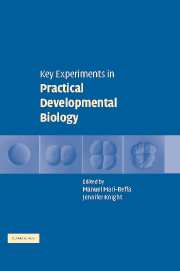Book contents
- Frontmatter
- Contents
- List of contributors
- Preface
- Introduction
- SECTION I GRAFTINGS
- SECTION II SPECIFIC CHEMICAL REAGENTS
- 4 Chemotaxis of aggregating Dictyostelium cells
- 5 Inhibition of signal transduction pathways prevents head regeneration in hydra
- 6 Retinoic acid during limb regeneration
- SECTION III BEAD IMPLANTATION
- SECTION IV NUCLEIC ACID INJECTIONS
- SECTION V GENETIC ANALYSIS
- SECTION VI CLONAL ANALYSIS
- SECTION VII IN SITU HYBRIDIZATION
- SECTION VIII TRANSGENIC ORGANISMS
- SECTION IX VERTEBRATE CLONING
- SECTION X CELL CULTURE
- SECTION XI EVO–DEVO STUDIES
- SECTION XII COMPUTATIONAL MODELLING
- Appendix 1 Abbreviations
- Appendix 2 Suppliers
- Index
- Plate Section
- References
4 - Chemotaxis of aggregating Dictyostelium cells
Published online by Cambridge University Press: 11 August 2009
- Frontmatter
- Contents
- List of contributors
- Preface
- Introduction
- SECTION I GRAFTINGS
- SECTION II SPECIFIC CHEMICAL REAGENTS
- 4 Chemotaxis of aggregating Dictyostelium cells
- 5 Inhibition of signal transduction pathways prevents head regeneration in hydra
- 6 Retinoic acid during limb regeneration
- SECTION III BEAD IMPLANTATION
- SECTION IV NUCLEIC ACID INJECTIONS
- SECTION V GENETIC ANALYSIS
- SECTION VI CLONAL ANALYSIS
- SECTION VII IN SITU HYBRIDIZATION
- SECTION VIII TRANSGENIC ORGANISMS
- SECTION IX VERTEBRATE CLONING
- SECTION X CELL CULTURE
- SECTION XI EVO–DEVO STUDIES
- SECTION XII COMPUTATIONAL MODELLING
- Appendix 1 Abbreviations
- Appendix 2 Suppliers
- Index
- Plate Section
- References
Summary
OBJECTIVE OF THE EXPERIMENT In the course of Dictyostelium development, a multicellular organism is established by the aggregation of single cells. In the following experiment, the chemoattractant that guides cell movement in an aggregation field is replaced by treating cells with cyclic AMP diffusing out of a micropipette. By the use of a micropipette that is easily moved by a micromanipulator, the direction of diffusion gradients can be changed fast enough to study the response of the cells within the first few seconds of reorientation.
DEGREE OF DIFFICULTY The cultivation of Dictyostelium and preparation of chemotactically responsive cells is easy. Manipulation of the micropipette requires some skill and endurance.
INTRODUCTION
Prokaryotic as well as eukaryotic cells are capable of responding to concentration radients of chemical compounds, but the mechanisms of their orientation within these gradients are different. The best studied examples are bacteria that swim by flagella rotation and eukaryotic cells that migrate by actin-based shape changes on a substrate surface. Bacteria such as Escherichia coli or Salmonella strains control the rotation of their flagella motors: counterclockwise rotation results in smooth swimming by bundled flagellae, whereas clockwise rotation leads to tumbling caused by separation of the flagellae. These small bacterial cells use temporal changes of chemoattractant to find the source of a gradient: when they swim toward the source, concentration will increase with time and tumbling is suppressed. The tumbling frequency is increased when bacteria swim in the opposite direction.
- Type
- Chapter
- Information
- Key Experiments in Practical Developmental Biology , pp. 50 - 66Publisher: Cambridge University PressPrint publication year: 2005



